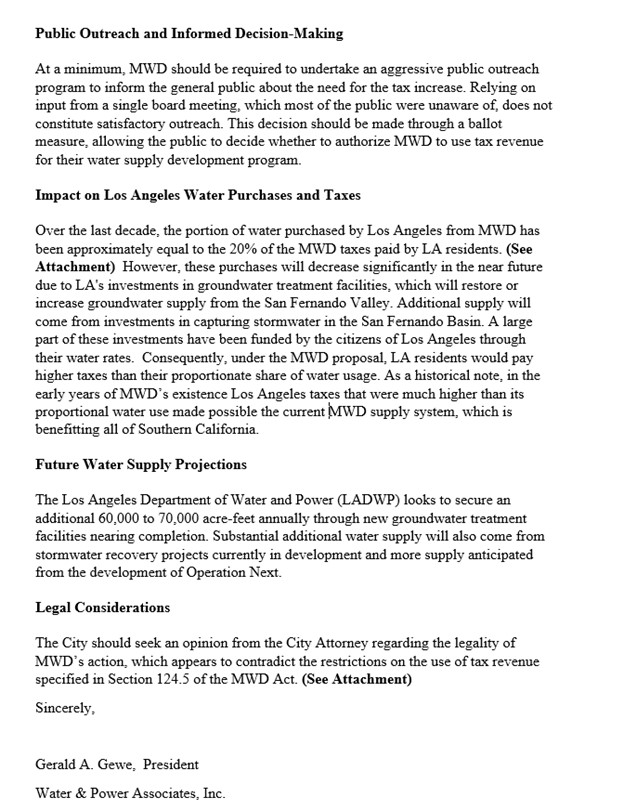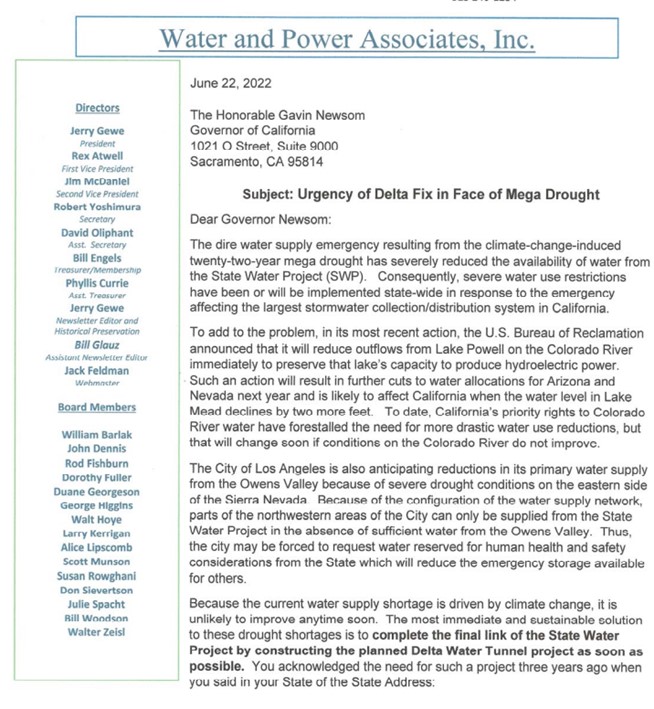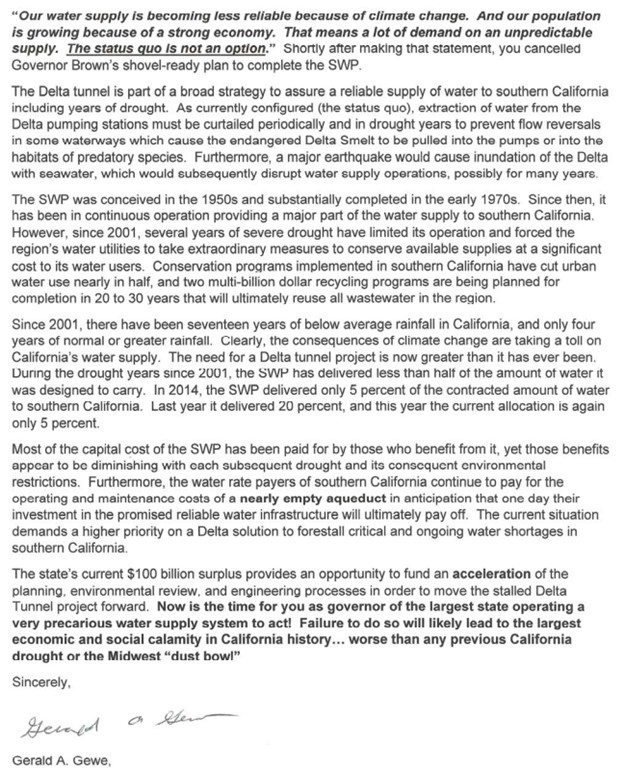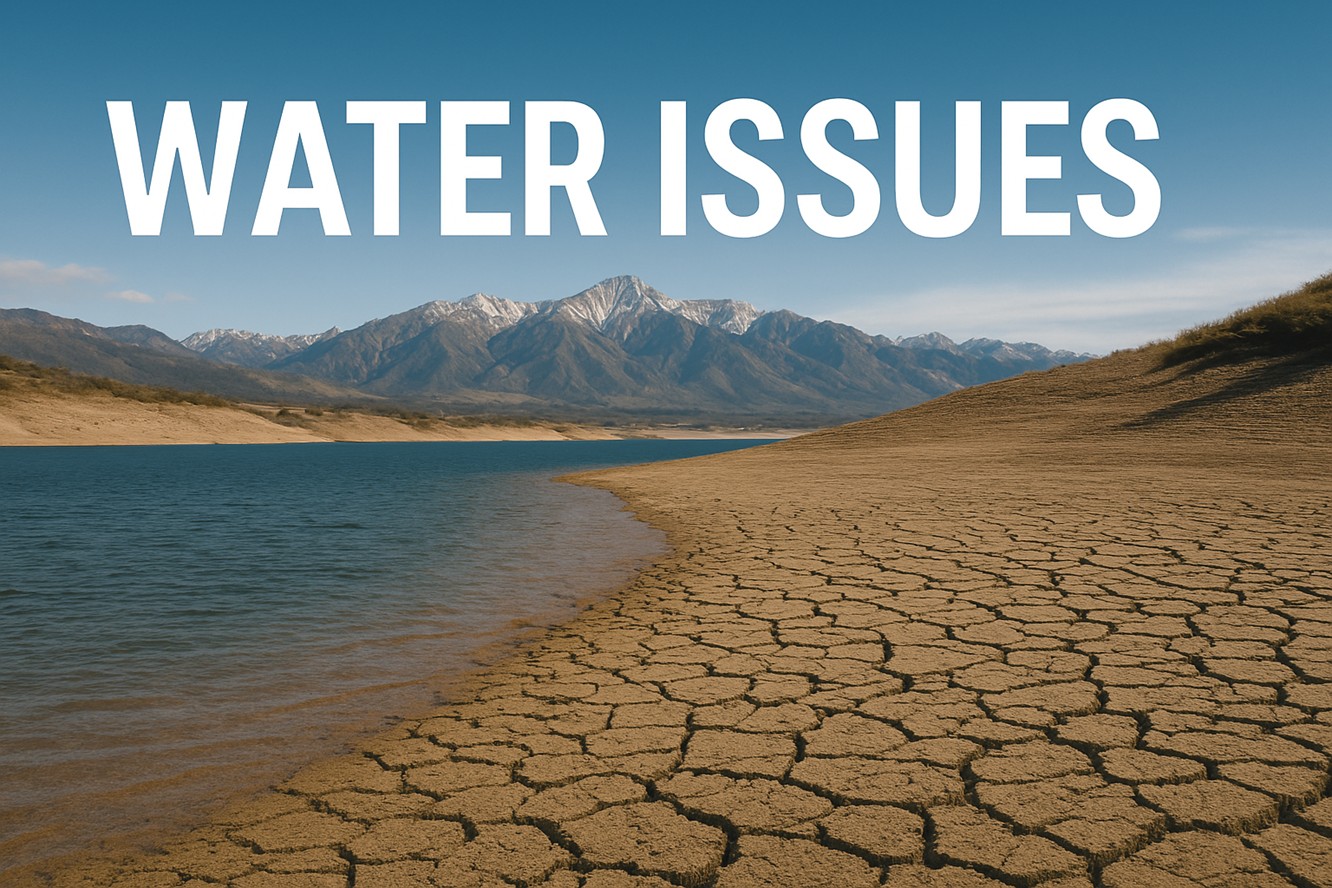MWD Proposal to Inrease Property Taxes to Fund New Water Supply Facilities



* * * * * |
Urgency of Delta Fix in Face of Mega Drought


* * * * * |
Letter of Support - California WaterFix Project
Randy A. Record, Board Chairman
Re: California WaterFix Project – Support Dear Mr. Record and Mr. Kightlinger: I am writing on behalf of the Los Angeles Water and Power Associates (Associates), a 501c(4) corporation established in 1971 to support sound water and energy policies for the City of Los Angeles, Southern California and the State of California. Included on our Board of Directors are three past Assistant General Managers-Water for the Los Angeles Department of Water and Power. The Associates urges the Board of the Metropolitan Water District to support the staff proposal to commit to California Water Fix Project, Phase 1, (Water Fix) at its Board Meeting of April 10th. Southern California ratepayers and taxpayers have already paid for the capital facilities needed to deliver the water that will be provided by the Water Fix. We’ve been waiting 50 years for the final link to be built and during that time, we’ve been paying for O&M costs of those facilities that are on average delivering half the water we were promised. The investment by Southern California of $5.4 billion to construct the Phase I facilities of the Water Fix will continue to provide the foundation for Southern California’s water supply reliability that will be augmented by the development of local supplies in a cost effective manner. Known alternatives to replace the water and reliability that will be developed through the Water Fix would be substantially more costly and would cause an even greater increase in water rates. The Water Fix is a regional solution that will benefit all of Southern California. However, for the San Fernando Valley area of the City of Los Angeles and Ventura County, the Water Fix is the only way to assure continued water supply in the event that an earthquake hits the Sacramento Delta. Such a disaster would otherwise interrupt water flow for a number of years while the salt is flushed from the Delta to the Pacific Ocean. In short, we believe that it is in the best interest of the City of Los Angeles and all of Southern California for the Metropolitan Water District of Southern California to support this vital project to ensure a reliable water supply for the City of Los Angeles as well as all of Southern California.
Truly yours, Edward Schlottman, President cc: MWD of Southern California Board of Directors
|
* * * * * |
The Delta Water Fix – A Key to Water Reliability, Sustainability
The City of Los Angeles has grown to a metropolis of over four million people, due in large part to the availability of a safe and reliable supply of water. However, providing this supply took a tremendous amount of foresight, planning, and investment. Over 80 percent of the City’s water supplies originate from sources hundreds of miles away—about 54% from the State Water Project via the Sacramento/San Joaquin Delta, 20% from the Eastern Sierra via the Los Angeles Aqueduct and 10% from the Metropolitan Water District’s Colorado River Aqueduct, The remaining 16 percent of the total supply comes from local groundwater and recycled water. Although the City’s population and economy have steadily grown, the sources of water have remained the same. Consequently, one of the greatest challenges facing the City is providing a reliable water supply while balancing a variety interests, including its commitment to protect and preserve the environment. This balancing act includes planning for the effects of climate change, mitigating against the risk of earthquakes, making proactive investments in local supplies, increasing water-use efficiency, and striving to keep water rates affordable. Even with efforts to increase conservation and develop additional local water supplies, water from the Sacramento-San Joaquin Delta will remain a critical component of the City’s water-reliability equation. Unfortunately, the reliability of imported supplies that support both Los Angeles and all of Southern California are at risk due to pumping restrictions, deteriorating environmental conditions in the Delta, and an aging system. State and federal agencies want to modernize this system through a project known as the California WaterFix which has both water delivery and environmental benefits. The California WaterFix doesn’t just provide environmental benefits for the Delta, it’s also essential for ensuring future water reliability for Los Angeles. When completed, the project will provide the following benefits: • Improves the ability to capture water during major storm events, ultimately storing this water under ground and in reservoirs for Los Angeles in years of drought; • Protects ecosystems and fish in the Delta by constructing intakes with state-of-the-art fish screens; • Protects the billions of dollars invested by Los Angeles to build and maintain the State Water Project, which transports the City’s supplemental water supply from the Delta. As water agencies in southern California prepare to make decisions on whether to support the California WaterFix, they need to set aside politics and support this project as part of a comprehensive approach to ensuring future water reliability. One can only imagine the calamity that would ensue when, not if, storms or a major earthquake cause a significant breach in the Delta levee system. This would be catastrophic, causing seawater intrusion that could contaminate a third of southern California’s freshwater supply and interrupt exports from the southern part of the Delta. Depending on the extent of the damage, it could take 6 to 24 months to repair the system and restore operations. And longer-term disruptions are certainly possible, causing major impacts on the economy and quality of life in Los Angeles. Without the WaterFix or an equivalent solution, this scenario is likely to play out. According to a study by the Los Angeles County Economic Development Corporation**, loses from a 24-month outage of the State Project would result in a loss of 742,000 job-years of employment, $75 billion of gross domestic product (GDP), and $135 billion of sales revenue for businesses in LA County.San Fernando Valley is especially vulnerable to a shortage of State Water supplies. In years when the LA Aqueduct is nearly dry (as happened in 2016), the San Fernando Valley is heavily dependent on imported supplies from the State. Due to the way the MWD and LA systems are plumbed, not enough Colorado River water can make it to the Valley to avoid a shortage. Plans to reduce the City’s dependence on supplies from the Delta and Colorado River, are wise. However, even when the City meets its 2040 local water supply and conservation goals, Angelenos will still be highly dependent on supplies from MWD in dry years, and the majority of this water will still need to come from the Sacramento/San Joaquin Delta. The process to finalize the design, operation, cost allocation, and financing of the California WaterFix is designed to be open and transparent. Estimates indicate that the project can be very cost effective for LA ratepayers, raising water bills by only $2 to $3 per month for the typical residential user^^. These costs pale in comparison to the economic and quality-of-life impacts of a catastrophe in the Delta, and the ensuing loss of water deliveries from the State Water Project. Amidst all the different arguments, opinions, and perspectives, we need to stay focused on the WaterFix as a way of ensuring future water-supply reliability for the City of Los Angeles and the region as part of a diverse water supply portfolio.
By Jim McDaniel, Jerry Gewe and Duane Georgeson 9-10-17
(Note: McDaniel, Gewe and Georgeson, all now retired, served as Assistant General Managers at the Los Angeles Department of Water and Power in charge of the Water System from 2005 to 2015, 1999 to 2005 and 1982 to 1990, respectively. All three are currently on the Executive Board of Water and Power Associates.) |
* * * * * |
Should Desalination be a part of Los Angeles’ Water Supply for the Future?
| The current drought has again raised interest on the part of the public and water agencies in developing seawater desalination as a resource. We know that desalination represents a significant source in the water supplies of the Middle East. The construction of seawater desalination facilities also played a major role in Australia’s response to a decade-long drought in the 1990s, albeit at a substantially increased cost for water. Currently there are at least a dozen projects in California that are under consideration. The largest seawater desalination project in the western hemisphere is scheduled to become operational by the end of the year in San Diego, and the Orange County Water District is actively pursuing a similar project. The city of Santa Barbara is also almost completely rebuilding its 25 year old facility (built during the last major drought, but never put into full operation). What role can and should desalination play in the water supply for Los Angeles? In early 2000, Los Angeles Mayor James K. Hahn, after a trip to Israel, encouraged the L.A. Department of Water and Power (LADWP) to investigate the role that seawater desalination should play in Los Angeles’ water supply. In response, the LADWP developed a conceptual plan for a modest sized project to be co-located with its Scattergood Power Generating Station near the Los Angeles International Airport. This plan would have allowed the LADWP to gain firsthand knowledge and experience in the technology with a minor impact on rates. The Scattergood Generating Station had an existing seawater intake for plant cooling that was to be used as the desalination source and existing available space that would have allowed for new plant construction without purchasing any additional land. The proposed capacity of 10 MGD (million gallons per day) would have served the area in the vicinity of the plant with minimal requirements for pumping and distribution. The disposal of brine that results from the desalination process would have been handled by the existing city of Los Angeles Hyperion Wastewater Treatment Plant outlet; this method of brine disposal was considered at the time as environmentally beneficial as it would have raised the salinity level of Hyperion's discharge effluent closer to that of the ocean. While this desalinated water would have been more expensive than purchases from the Metropolitan Water District at that time, the overall cost impact would have been negligible, as the quantity delivered would have been less than two percent of LA’s overall water supply. In actuality, projected costs would have been within the range of the some of the more expensive water recycling projects under consideration at the time. However, interest in the proposed desalination project eventually waned in favor of continued focus on water conservation, wastewater recycling and storm water capture. In light of the current drought and ongoing long-term water supply issues, Los Angeles should carefully study and critically evaluate the desirability of adding some measure of desalinated water to the city’s water supply portfolio. This is not to suggest immediately beginning construction, since it is likely (although not certain) that the current crisis will be over long before a facility could be built. Much information should become available from the first few years of operation of the San Diego project, although information sharing may be severely limited due to the private ownership of the facility and the owner's desire to protect competitive advantage. The Santa Barbara facility will be another, likely more open, source of information. Los Angeles should do all it can to encourage information sharing through the regulatory and permitting processes for the benefit of the entire state. It is unlikely that desalination of seawater will be a "magic bullet" to solve all of California’s water issues due to the limited number of feasible sites and the immense cost that would be involved in facility construction and moving the water from sea level elevation where it would originate to inland areas where water demand is highest. However, there is substantial water use in coastal Southern California and desalinated water could provide a significant benefit to local water supply reliability (as a drought-proof source) and to the economies of Los Angeles and the Southern California region. Conservation, as the cheapest and most immediate source of water, has been mandated by Governor Brown to reduce California's urban water use in response to the current drought. However, conservation alone cannot be counted on to fully offset the effects of future droughts as well as increasing demands due to population growth and continuing water allocations for the environment. Therefore, serious consideration should be given to expanding Los Angeles' current water supply portfolio (traditional sources, recycled water, storm water capture) to include desalination, a proven source of water in the middle east and Australia, to reliably meet LA's water needs of the future.
Jerry Gewe 6-11-15
(Note: Jerry Gewe is a retired Assistant General Manager, LADWP Water System and is currently on the Executive Board of Water and Power Associates.) |
* * * * * |
Menu
- Home
- Mission
- Museum
- Major Efforts
- Recent Newsletters
- Historical Op Ed Pieces
- Board Officers and Directors
- Mulholland/McCarthy Service Awards
- Positions on Owens Valley and the City of Los Angeles Issues
- Legislative Positions on
Water Issues
- Legislative Positions on
Energy Issues
- Membership
- Contact Us
- Search Index
